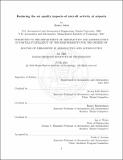| dc.contributor.advisor | Steven R.H. Barrett. | en_US |
| dc.contributor.author | Ashok, Akshay | en_US |
| dc.contributor.other | Massachusetts Institute of Technology. Department of Aeronautics and Astronautics. | en_US |
| dc.date.accessioned | 2016-10-25T19:18:11Z | |
| dc.date.available | 2016-10-25T19:18:11Z | |
| dc.date.copyright | 2016 | en_US |
| dc.date.issued | 2016 | en_US |
| dc.identifier.uri | http://hdl.handle.net/1721.1/105005 | |
| dc.description | Thesis: Ph. D., Massachusetts Institute of Technology, Department of Aeronautics and Astronautics, 2016. | en_US |
| dc.description | This electronic version was submitted by the student author. The certified thesis is available in the Institute Archives and Special Collections. | en_US |
| dc.description | Cataloged from student-submitted PDF version of thesis. | en_US |
| dc.description | Includes bibliographical references (pages 140-161). | en_US |
| dc.description.abstract | Air transportation is an integral part of the economy and the transportation infrastructure. However, aircraft activity at airports generates CO2 emissions that affect the climate and other pollutants that affect air quality and human health. The focus of this thesis is to enable the reduction of the air quality impacts of aircraft operations at airports by (1) advancing the understanding of the relationship between aircraft activity and its air quality impacts and (2) evaluating the air quality benefits of controlling aircraft operations. There are atmospheric conditions where decreasing fuel burn (which is directly proportional to CO2 emissions) results in increased population exposure to fine particulate matter (PM2.5) and ozone (O3). This thesis quantifies the duration and magnitude of the tradeoffs between CO2 emissions and population exposure. The research complements current studies that optimize aircraft operations at airports for CO2 emissions but have not quantified the air quality implications of doing so. This raises the possibility of reducing the air quality impacts of airports beyond focusing only on minimizing fuel burn. Next, this thesis characterizes the atmospheric conditions that give rise to tradeoffs between emissions and population exposure to ozone. The ozone exposure response to nitrogen oxide (NOx) and Volatile Organic Compound (VOC) emissions is quantified as a function of ambient NOx and VOC concentrations using ozone exposure isopleths. This is the first time that ozone exposure isopleths are created for all locations in the US, using emission sensitivities from the adjoint of an air quality model. Metrics are calculated based on the isopleths which can be used to determine whether NOx and VOC emission reductions will improve ozone exposure or be counter-productive and the optimal NOx/VOC reduction ratio. Finally, this thesis calculates, for the first time, the air quality and climate benefits of pushback control and de-rated takeoffs for simulated aircraft operations at the Detroit Metropolitan Wayne County Airport (DTW). Operations are also optimized for minimum air quality, environmental and fuel combustion-related costs. The results show that the gate holding strategy is effective in mitigating the environmental impacts of taxi operations at airports, reducing CO2 emissions and air quality impacts by 35-40% relative to a baseline without gate holds. De-rated takeoffs at 75% thrust are effective in reducing the air quality impacts of takeoff operations by 19% but increase fuel burn by 3% relative to full-thrust takeoffs. Environmental costs are minimized with average optimal thrust setting of 81%, while maintenance cost savings are estimated to be 2 orders of magnitude larger than the increase in fuel costs from de-rated takeoffs. | en_US |
| dc.description.statementofresponsibility | by Akshay Ashok. | en_US |
| dc.format.extent | 161 pages | en_US |
| dc.language.iso | eng | en_US |
| dc.publisher | Massachusetts Institute of Technology | en_US |
| dc.rights | M.I.T. theses are protected by copyright. They may be viewed from this source for any purpose, but reproduction or distribution in any format is prohibited without written permission. See provided URL for inquiries about permission. | en_US |
| dc.rights.uri | http://dspace.mit.edu/handle/1721.1/7582 | en_US |
| dc.subject | Aeronautics and Astronautics. | en_US |
| dc.title | Reducing the air quality impacts of aircraft activity at airports | en_US |
| dc.type | Thesis | en_US |
| dc.description.degree | Ph. D. | en_US |
| dc.contributor.department | Massachusetts Institute of Technology. Department of Aeronautics and Astronautics | |
| dc.identifier.oclc | 960853163 | en_US |
